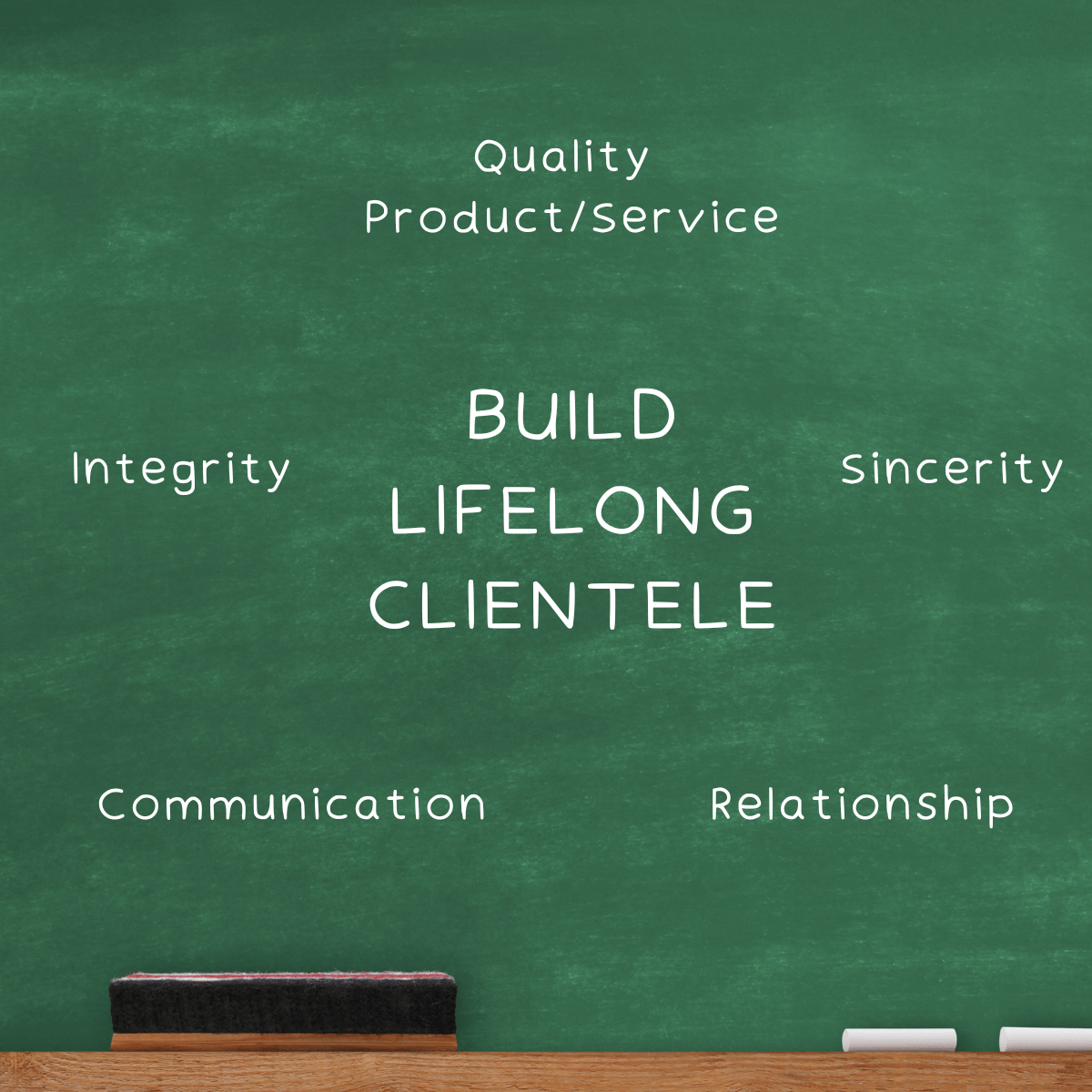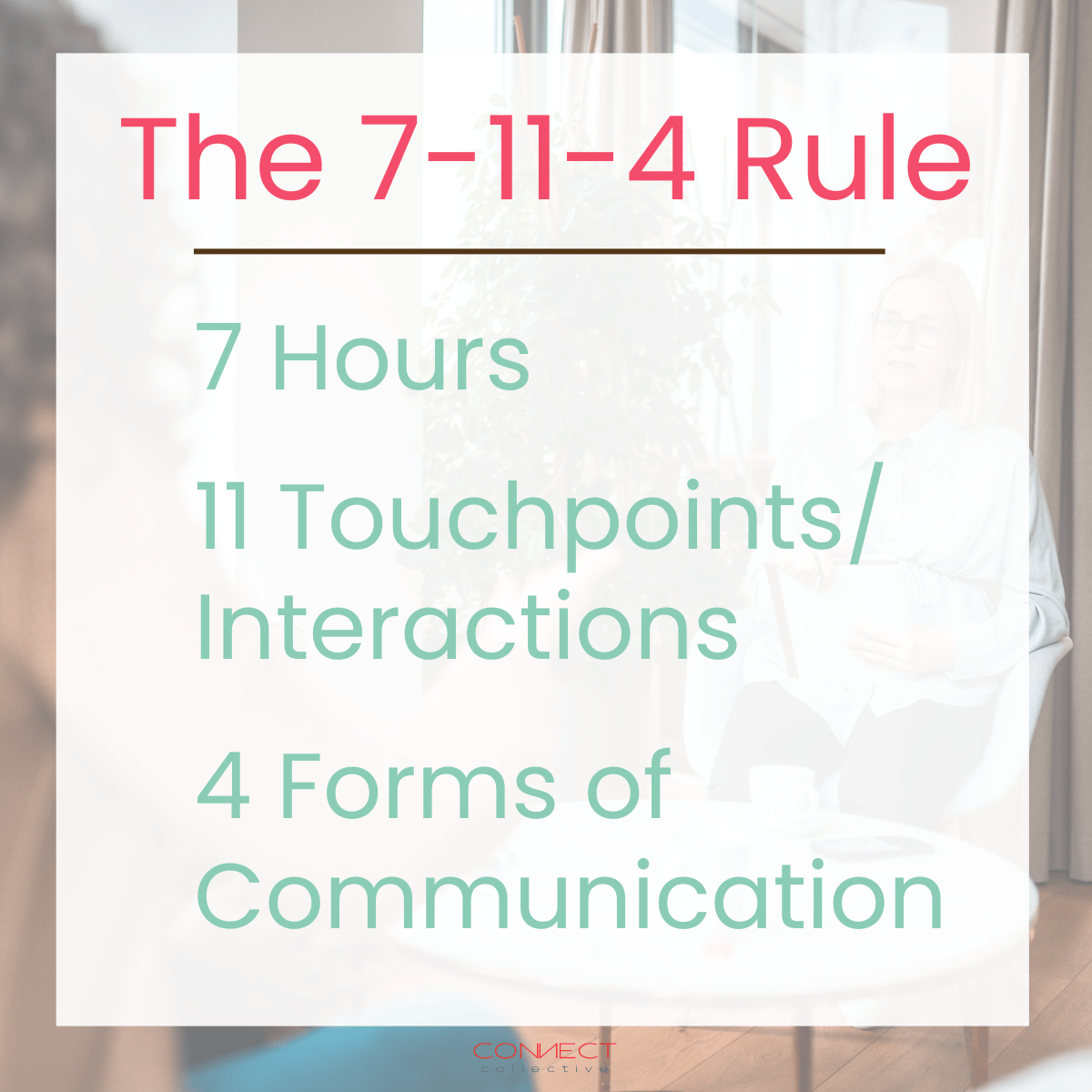- CONNECT collective
- Posts
- Mastering the 7-11-4 Rule for Building Lifelong Customers
Mastering the 7-11-4 Rule for Building Lifelong Customers

Ever wonder why some businesses turn one-time buyers into raving fans, while others struggle to get a second sale (if they even get the first one)?
Based on my observations working with small businesses and solopreneurs across industries is this: Business owners have an “If I build it, they will come” belief about client acquisition.
This belief may initially be supported by an influx of interest when a business first hangs its shingle. The novelty creates excitement, but does it sustain sales? Typically, no.
Not every buyer is a customer or client for life. However, converting new buyers into raving fans is what makes your business sustainable.
All businesses are built on a mix of established and one-off consumers.
Think of potential clients/customers the way you would any other relationship. You interact with people every day. Some of those people become acquaintances. Some of those acquaintances become friends. And, some of those friends enter your inner circle.
One of the ways you can acquire new clients and move them from curious browsers to loyal customers is to leverage the 7-11-4 Rule.
The Problem: Chasing Quick Sales Undermines Long-Term Success
Buckle up, ‘cause I’m getting ready to dive into Honest Voice mode.
Have y’all felt the weight lately? Everyone is exhausted. Business people are exhausted. They’re networking and creating content to scope out new customers, and it’s exhausting. The people at the networking events are exhausted. Prospective clients are exhausted. And, viewers of your content (again, potential customers) are exhausted.
This exhaustion is a symptom of a problem that has been building for years.
My personal opinion is that we are emerging from a cycle of rapid conversions (e.g., the focus on lead gen, funnels, and evergreen digital products) paired with consumers with an extraordinarily voracious appetite (especially post-pandemic).
It reached a fever pitch. Anyone with a convincing promise of fast money and a digital course could make bank. Anyone with a halfway decent marketing campaign could sell their services and catch a net full of new customers.
Now, we’re seeing the results of this frenzy.
Customers feel like transactions, not valued partners.
Lack of trust leads to low retention and poor brand loyalty.
Short-term tactics (e.g., discounts, pushy sales) erode credibility.
What happened? People bought. People consumed. And people were greatly disappointed.
I’ve been excitedly waiting for this to happen. It sounds a little sadistic, but I promise it’s a good thing. Everything goes through a cycle of birth, growth, and death. We’re in the death phase now . . . and rebirth is right around the corner.
This is the current state:
High turnover rates and wasted marketing spend on increasingly failing campaigns.
Years of missed opportunities to build a loyal customer base.
A decline in clientele based on oversaturation and lack of spendable funds.
You may call this a problem. I call it a golden (and possibly rare) opportunity.
Businesses have prioritized immediate revenue over relationship-building, underestimating the value of trust and engagement. The irony is everyone is proclaiming “Add value!” Meanwhile, they themselves have forgotten what value actually is.
I invite you to explore the 7-11-4 Rule as a solution that counters this mindset and fosters deeper connections
The Solution: The 7-11-4 Rule for Building Lifelong Fans
The 7-11-4 Rule represents 7 hours, 11 interactions, 4 forms of communication:
7 Hours: Customers need 7+ hours of meaningful engagement to trust your brand (your product, your service, or you as the brand).
11 Interactions: Multiple touchpoints (e.g., emails, social posts, webinars) build familiarity.
4 Channels: Use varied platforms (e.g., email, social media, website, video) to connect.
This approach builds trust through consistent, value-driven interactions. Legitimate, true value, not fluff in flashy packaging. The result is customers see your brand as a partner, not a vendor. You're forming a relationship. It may be acquaintance, friend, or inner circle level. Regardless, you know them, and they know you.
Nurture your clientele with CARE (your content framework):
Connect: Initiate contact through accessible channels (e.g., social media DMs, email welcomes).
Add Value: Provide free, useful content (e.g., guides, tips, videos) to solve problems.
Relate: Share stories, testimonials, or behind-the-scenes content to humanize your brand.
Engage: Invite two-way interaction (e.g., polls, replies, live Q&As) to deepen trust.
When you’re in business you’re in it for the long game, right? Then, you need to focus on developing long-term relationships. Be patient, provide a quality experience. And, turn off your “Sell!” switch.
What would it look like if you implemented the CARE model to support your marketing approach?
Ask yourself, “What do my current and future clients/customers want to know?”
Who you are.
What you do.
How you do it.
Why you do it.
The benefits to them.
Communicate clearly and consistently through content to build your following over time.

Implementing the 7-11-4 Rule: Practical Steps
Step 1 - Map Your Channels:
Identify 4+ platforms where your audience is active (e.g., Instagram, email, YouTube, blog). Start with 1 channel and get in your reps. That means get consistent posting on one channel before you add a second (then a third, then a fourth).
My Approach: I started with this newsletter a little over two years ago. Then, I added Facebook. Then, I transitioned to X for several months before adding YouTube. Finally, I’ve added LinkedIn. There were several months in between adding platforms. Do this to stay sane.
Step 2 - Plan 11 Touchpoints:
Create a mix of content (e.g., 3 emails, 4 social posts, 2 videos, 2 blog posts) that align with the CARE model.
My Approach: I started off with one weekly email for several months. Then, I folded in 3-5 Facebook posts a week. I limited Facebook as I moved to X (7-10 posts a week). LinkedIn was then added with two posts a week (now 3-4).
Step 3 - Spread Over 7 Hours:
Distribute touchpoints over weeks to avoid overwhelming customers (e.g., a 10-minute video, a 5-minute blog read). These 7 hours are cumulative for the consumer. One consumer of your content may engage in 7 hours of content in a single day, while another takes five months.
My Approach: I upload one 10-15 minute video a week on YouTube with 2-3 community tab posts. This is to connect with my viewers and engage them in conversation. My LinkedIn posts can be consumed in 1-2 minutes and articles can be read in five minutes. I’m always aware of how much time I’m asking my audience to give me. Their attention is a gift, and I treat it with respect.
Step 4 - Track Engagement:
Use analytics to monitor interactions and adjust based on what resonates.
My Approach: I use analytics to create content my audience wants. If they are engaged, I create more of that type/style of content. If they aren’t engaged, I do less. It’s that simple.
Also, I all but ignore analytics outside these basics. Analytics don’t tell the full story (e.g., a great piece gets zero engagement, while a fluff piece takes off). It depends on your goals. I am trying to strike a balance between what people want and what I want them to learn. I’m here to educate.
Just keep in mind that analytics are a guide. Make sure you’re basing decisions on quality data, and that you understand the data you're parsing.
Focus on quality over quantity—each interaction should feel authentic and customer-centric.
Tools to Help: Start with free. I use the free version of Beehiiv for my newsletter, as well as the free version of Buffer to schedule my posts. I use free AIs to help construct my outlines.
My Final Word: From Quick Bucks to Lifelong Fans
We are coming to the end of a cycle when businesses chasing quick sales have missed out on loyal customers.
Sustained success requires prioritizing relationships over revenue and staying consistent. Our solution is the 7-11-4 Rule which, applied through the CARE model, builds trust and lifelong fans.
Your Action Plan: Audit your current customer journey this week. Pick 1 channel (slowly and consistently building to 4), and start planning 11 touchpoints using the CARE model.
You don’t need to be exact in your execution of the 7-11-4 Rule. Use it as a guide with the understanding that your intention is to earn trust through connection.
Invest in your customers today, and they’ll invest in you for years to come.
Join CONNECT-collective on YouTube and LinkedIn!
I would love to have you as part of the CONNECT-collective community on our other platforms. If you are a solopreneur or entertaining starting your own solo business, I invite you to check out CONNECT-collective on YouTube!\ and LinkedIn! I talk about starting solo businesses to escape your 9-5 while avoiding burnout. I would love to see you there!
Have a Question or Want to Suggest a Topic?
I am here for you. If you have a question, want to suggest a topic, or just want to say, “Hello!” I would love to hear from you. Send me an email at [email protected]
Sending you all Peace, Love, & Harmony!
-Michele

Do You Need Help Tapping Into Your Potential?
Are you struggling to meet your goals and wish you had support? Have you ever considered working with a coach? You may not know what a coach does.
One-on-One Coaching:
You and I develop an individualized plan targeting your specific goals
You receive individualized support from me
Answers to your specific questions
Guidance on your specific issues and blocks
Accessibility to me outside coaching sessions for added support (individual texts and emails to check in)
Your plan leads to learning how your personal growth is in your control
Are you ready to take action but are at a loss on what step to take next?
I can teach you how to get started and accelerate your growth by using repeatable methods. Need the tools? I’ve got them. The goal is always to make you independent. I should be working myself out of a job. Once you take off, you may want to have a session from time to time, especially if you are scaling your goals. A good coach teaches you how to stand on your own two feet. Contact me today ([email protected]). Are you ready to CONNECT?